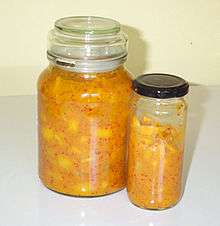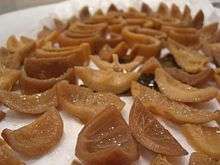Preserved lemon



Preserved lemon or lemon pickle is a condiment that is common in South Asian and North African cuisine. It is also known as "country lemon" and leems. Diced, quartered, halved, or whole, lemons are pickled in a brine of water, lemon juice, and salt; occasionally spices are included as well.[1] The pickle is allowed to ferment at room temperature for weeks or months before it is used. The pulp of the preserved lemon can be used in stews and sauces, but it is the peel (zest and pith together) that is most valued. The flavor is mildly tart but intensely lemony.
Usage
Pieces of pickled lemon may be washed before using to remove any surface salt, or blanched to remove more of the salt and bring out the natural mild sweetness. They may then be sliced, chopped, or minced as needed for the texture of the dish. The rind may be used with or without the pulp.
Preserved lemon is the key ingredient in many Moroccan dishes such as tagines. In Cambodian cuisine, it is used in dishes such as Ngam nguv, a chicken soup with whole preserved lemons. They are often combined in various ways with olives, artichokes, seafood, veal, chicken, and rice.
The pickled pulp and liquid can be used in Bloody Marys and other beverages where lemon and salt are used.[2] The flavor also combines well with horseradish, as in American-style cocktail sauce.
In Ayurvedic cuisine, lemon pickle is a home remedy for stomach disorders, and its value is said to increase as it matures.[3] In East African folk medicine, lemon pickle is given for excessive growth of the spleen.[4]
Variations
Lime and grapefruit also are pickled in this manner.
History
Historically, pickling was an affordable and practical method of preserving lemons for use long after their season and far away from where they are grown. Early 19th-century English, American, and (in translation) Indian cookbooks give recipes for lemon pickle and mention its use in sauces for salmon, veal, etc.;[5][6][7][8] dishes where today fresh lemon zest and/or juice would be used.
An early 19th century recipe is as follows, taken from A New System of Domestic Cookery:
They should be small, and with thick rinds: rub them with a piece of flannel; then slit them half down in four quarters, but not through to the pulp; fill the slits with salt hard pressed in, set them upright in a pan for four or five days, until the salt melts; turn them thrice a day in their own liquor, until tender; make enough pickle to cover them, of rape-vinegar, the brine of the lemons, Jamaica pepper, and ginger; boil and skim it; when cold, put it to the lemons, with two ounces of mustard-seed, and two cloves of garlic to six lemons. When the lemons are used, the pickle will be useful in fish or other sauces.
A similar recipe appears in Mary Randolph's 1824 cookbook.[9] Similar recipes also appear in earlier cookbooks, such as the 18th century cookbook by English housekeeper Elizabeth Raffald.[10] Some recipes include grating or thinly peeling the lemons, and preserving the peels (zest) which were dried for later use.[6]
See also
References
| Wikimedia Commons has media related to Pickled lemons. |
- ↑ Herbst, Sharon. Food Lover's Companion (3rd ed), pg 492, Barron's Educational Series Inc.
- ↑ Ruth Reichl; Zanne Early Stewart; John Willoughby, eds. (2006). The Gourmet Cookbook: More Than 1000 Recipes. Houghton Mifflin Harcourt. pp. 359–360. ISBN 0-618-80692-X.
- ↑ Harish Johari (2000). Ayurvedic healing cuisine: 200 vegetarian recipes for health, balance, and longevity. Inner Traditions / Bear & Company. p. 29-20. ISBN 0-89281-938-3.
- ↑ Traditional food plants: A resource book for promoting the exploitation and consumption of food plants in arid, semi-arid and sub-humid lands of Eastern Africa. FAO Food and Nutrition Paper. Food & Agriculture Org. 1988. p. 199. ISBN 92-5-102557-6.
- ↑ Farley, John (1811). The London art of cookery and domestic housekeeper's complete assistant: uniting the principles of elegance, taste, and economy : and adapted to the use of servants, and families of every description (12 ed.). Printed for Scatcherd and Letterman.
- 1 2 3 A Lady (1826). A new system of domestic cookery: founded upon principles of economy, and adapted to the use of private families. John Murray.
- ↑ Rundell, Maria Eliza Ketelby (1844). A new system of domestic cookery: founded upon principles of economy, and adapted to the use of private families. Carey and Hart. pp. 24, 32–33, 158–159, 174 (recipe), etc.
- ↑ "Indian cookery, as practiced and described by the natives of the East". Miscellaneous translations from Oriental languages. 1. Sandford Arnot, translator. J. Murray for the Oriental Translation Fund. 1831. p. 33.
- ↑ Randolph, Mary (1824). The Virginia House-Wife (1984 facsimile ed.). University of South Carolina Press. pp. 200–201.
- ↑ Elizabeth Raffald (1786). The experienced English housekeeper (10 ed.). R. Baldwin. pp. 80–81.